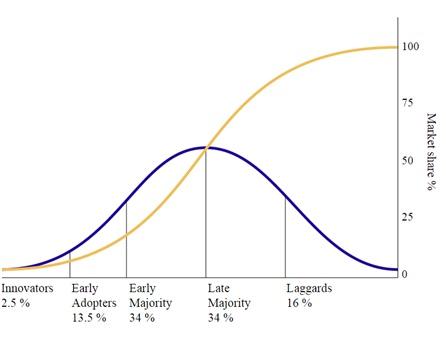- Business Concepts ›
- Marketing and Strategy ›
- Early Majority
Early Majority
Definition, Importance & Example
This article covers meaning & overview of Early Majority from marketing perspective.
What is meant by Early Majority?
Early majority are the large group of customers who buy products after a few customers have tried & given a positive feedback. Early majority is the group of consumers which comes after innovators and early adopters who take all the risk initially. Early majority tend to have small but some risk taking ability and adopt a new product after some time but they do before most of the other market.
Early majority is defined in Diffusion of Innovation theory which explains how a new product or technology is adopted (also referred to as TAM). The theory talks about five types of adopter categories of consumers, namely, the innovators, early adopters, early majority, late majority and the laggards.
Importance of Early Majority
The innovators and early adopters are the risk-takers, the technology enthusiasts who are aware of a new upcoming technology and won’t mind spending money to try it out. The early majority are the pragmatists who wait to buy the product/technology till they have established its usefulness and durability, as compared to earlier technologies/products in that field. The early majority usually has innovators/early adopters in its social circles and gathers feedback from them to make the decision of whether to buy or not. The consumers constituting late majority are the ones who do not have innovators/early adopters in their social circles, and don’t have the extra money to ‘try out’ new technology. They go for a new product only once it’s been widely accepted, i.e. by the earlier 50% of consumers. The laggards are the skeptics who do not buy until the product is well established, even old/outdated.
When creating a new technology/product, it is important to keep in mind the early majority. This is the group that accounts for the first sizeable sale of the product. But it’s impossible for any new technology to be readily accepted by this majority right away, as they are the careful, skeptical ones, relying heavily on more research. Hence any new technology/product needs to be designed such that it attracts innovators/early adopters while offering something to the early majority.

Read More
Examples of Early Majority
For example a new cell phone may have technological advancements like a 13MP camera with enhanced space, waterproof to a larger depth of water and extremely thin bendable body to attract the technology enthusiasts (innovators/early adopters), but the technology should be inexpensive and simple enough to be understood and adopted by the lay man (early majority). The early majority represents a large proportion of the market and getting success in this section of the market generally leads to better awareness and acceptability of the technology/product.
The exception would be of niche products where the brand wants to stick to the innovators and early adopters. In such cases, the products will have some specific and complex features at a higher price.
For example, while Apple’s products appealed to the innovators for their different hardware and software design and feature specifications, they did well with the masses too when the price was brought down a little, because the technology was understandable and the product affordable by the early majority.
Hence, this concludes the definition of Early Majority along with its overview.
This article has been researched & authored by the Business Concepts Team which comprises of MBA students, management professionals, and industry experts. It has been reviewed & published by the MBA Skool Team. The content on MBA Skool has been created for educational & academic purpose only.
Browse the definition and meaning of more similar terms. The Management Dictionary covers over 1800 business concepts from 5 categories.
Continue Reading:
What is MBA Skool?About Us
MBA Skool is a Knowledge Resource for Management Students, Aspirants & Professionals.
Business Courses
Quizzes & Skills
Quizzes test your expertise in business and Skill tests evaluate your management traits
Related Content
All Business Sections
Write for Us